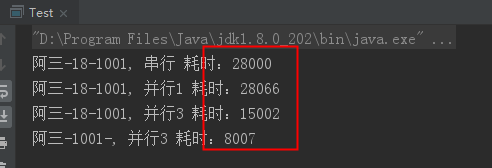使用ThreadPoolExecutor线程池实现并发操作并返回结果
在日常业务开发中,有时对一些没有关联的业务操作,如查询多个结果,使用串行调用并不是一个理想的处理方式,可以优化为使用线程池做并发调用,这样在一定程度上能提高性能,如下测试demo方法,使用TimeUnit.SECONDS.sleep(xxx)模拟业务处理时长:
public static String getName () throws Exception { TimeUnit.SECONDS.sleep(5); return "阿三"; } public static int getAge () throws Exception { TimeUnit.SECONDS.sleep(15); return 18; } public static String getBirthday () throws Exception { TimeUnit.SECONDS.sleep(8); return "1001"; }
1.串行调用耗时测试
// 1、串行测试 StopWatch watch = new StopWatch(); watch.start("串行"); String name = getName(); int age = getAge(); String birthday = getBirthday(); watch.stop(); System.out.println(name + "-" + age + "-" + birthday + ", 串行 耗时:" + watch.getTotalTimeMillis());
2.并行耗时测试
2.1 使用ThreadPoolExecutor的submit方法,参数为Callable类型的可以有返回值
public <T> Future<T> submit(Callable<T> task)
/** * 使用线程池 */ static ThreadPoolExecutor poolExecutor = new ThreadPoolExecutor(10, 20, 2000L, TimeUnit.SECONDS, new LinkedBlockingQueue<>()); public static void main(String[] args) throws Exception { // 2.并行测试1 StopWatch watch2 = new StopWatch(); watch2.start("并行"); // 此方式get方法阻塞了后面的服务,用法不对 String submit = poolExecutor.submit(() -> getName()).get(); Integer submit1 = poolExecutor.submit(() -> getAge()).get(); String submit2 = poolExecutor.submit(() -> getBirthday()).get(); watch2.stop(); System.out.println(submit + "-" + submit1 + "-" + submit2 + ", 并行1 耗时:" + watch2.getTotalTimeMillis()); // 3.并行测试2 StopWatch watch3 = new StopWatch(); watch3.start("并行2"); Future<String> future = poolExecutor.submit(() -> getName()); Future<Integer> future1 = poolExecutor.submit(() -> getAge()); Future<String> future2 = poolExecutor.submit(() -> getBirthday()); String submit3 = future.get(); Integer submit4 = future1.get(); String submit5 = future2.get(); watch3.stop(); System.out.println(submit3 + "-" + submit4 + "-" + submit5 + ", 并行3 耗时:" + watch3.getTotalTimeMillis()); }
2.2 对返回值为统一类型的可以使用invokeAll方法:
public <T> List<Future<T>> invokeAll(Collection<? extends Callable<T>> tasks)
// 4.并行测试3 StopWatch watch4 = new StopWatch(); watch4.start("并行3"); Callable<String> taskName = () -> getName(); Callable<String> taskBirthday = () -> getBirthday(); List<Callable<String>> taskList = Lists.newArrayList(); taskList.add(taskName); taskList.add(taskBirthday); List<Future<String>> futures = poolExecutor.invokeAll(taskList); StringBuilder sb = new StringBuilder(); for (Future<String> resultFuture : futures) { sb.append(resultFuture.get()).append("-"); } watch4.stop(); System.out.println(sb.toString() + ", 并行3 耗时:" + watch4.getTotalTimeMillis());
3.测试结果

可以看出最后两种方式耗时和最大耗时服务的用时差不多







 浙公网安备 33010602011771号
浙公网安备 33010602011771号